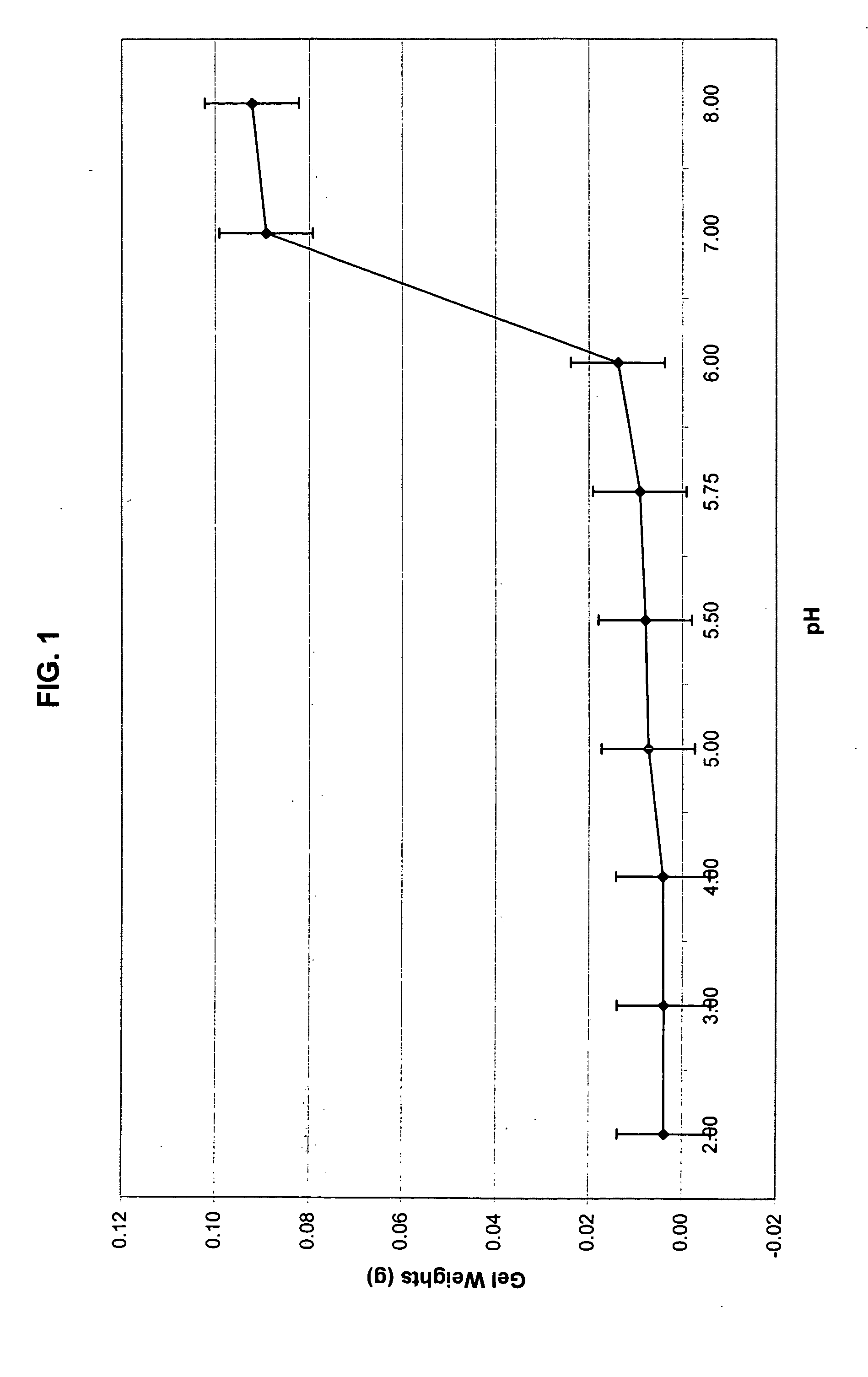Composition and method for treating bezoar and trichobezoar
- Summary
- Abstract
- Description
- Claims
- Application Information
AI Technical Summary
Benefits of technology
Problems solved by technology
Method used
Image
Examples
example 1
[0046] This experiment was conducted to characterize gel formation by various chitosan solutions. The experiment was conducted using 1.0% chitosan solutions prepared from three commercially available chitosans. The commercially available chitosans included:
[0047] Chitosan 1A—“Chitosan Tasteless / Odorless” from Premix (Iceland)
[0048] Chitosan 1B—“High Deacetylation Chitosan” (indicated as having no less than 78% deacetylation) from Premix (Iceland)
[0049] Chitosan 1C—ChitoClear® (indicated as having more than 90% deacetylation) from Premix (Iceland).
[0050] 1.0% chitosan solutions were prepared by mixing the chitosan (1.0 g) with 0.16N HCl (75 ml) for 15 minutes. An additional amount of 0.16N HCl was added to make a 100 ml solution and the solution was mixed for an additional 2 hours, 45 minutes. After the mixing period, the pH was measured and the chitosan solution was stored under refrigeration.
[0051] Gelling was measured by placing nine samples of the chitosan solution (10 g eac...
example 2
[0063] This experiment comprised an in vitro study of the effect of chitosan on hairball formation. The experiment was conducted using a 1.0% chitosan solution at pH 1.0.
[0064] Solutions of 1.0% chitosan were prepared by mixing chitosan (1.0 g) with 0.16N HCl (75 ml) for 15 minutes. An additional amount of 0.16N HCl was added to make a 100 ml solution and the solution was mixed for an additional 2 hours, 45 minutes. After the mixing period, the pH was measured and the chitosan solutions were stored under refrigeration.
[0065] The mixtures were evaluated by adding the chitosan solutions (10 g) to centrifuge tubes and adjusting the pH to about 1.0. A feline hairball (1-3 g) was added to each centrifuge tube and pH was measured. The tubes were closed and inverted for 1 minute before setting them in a water bath at 37° C. and 50-120 rpm for 2 hours.
[0066] The hairballs were next evaluated under intestine conditions by adding pH 10.5 carbonate / bicarbonate buffer (8.5 ml) to each tube. ...
example 3
[0068] This experiment comprised an in vitro study of the effect of chitosan and sodium phosphate dibasic in combination with various amounts of zinc acetate on hairballs at pH 3.0. The purpose of this study was to determine the effect of adding sodium phosphate dibasic and / or zinc acetate on chitosan gelling. The experiment was conducted using a 0.5% chitosan solution at pH 3.
[0069] A solution of 0.5% chitosan was prepared by mixing chitosan (0.5 g) with 0.16N HCl (75 ml) for 15 minutes. An additional amount of 0.16N HCl was added to make a 100 ml solution and the solution was mixed for an additional 2 hours, 45 minutes. After the mixing period, the pH was measured and the chitosan was stored under refrigeration.
[0070] The mixtures were evaluated under stomach conditions by adjusting the chitosan solution to pH 3.0 with sodium hydroxide. The chitosan solution (10 g) was then added to each of twelve centrifuge tubes. Various tubes then received additional amounts of sodium phospha...
PUM
| Property | Measurement | Unit |
|---|---|---|
| Fraction | aaaaa | aaaaa |
| Fraction | aaaaa | aaaaa |
| Fraction | aaaaa | aaaaa |
Abstract
Description
Claims
Application Information
 Login to View More
Login to View More - R&D
- Intellectual Property
- Life Sciences
- Materials
- Tech Scout
- Unparalleled Data Quality
- Higher Quality Content
- 60% Fewer Hallucinations
Browse by: Latest US Patents, China's latest patents, Technical Efficacy Thesaurus, Application Domain, Technology Topic, Popular Technical Reports.
© 2025 PatSnap. All rights reserved.Legal|Privacy policy|Modern Slavery Act Transparency Statement|Sitemap|About US| Contact US: help@patsnap.com



